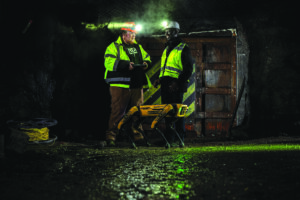
Dustin Peterson, left, recently assisted Dr. Kwame Awuah-Offei with research related to using a Boston Dynamics Spot robot for mine emergencies. Peterson and Awuah-Offei are shown here working with the robot in MS&T’s Experimental Mine. (Photo by Michael Pierce/Missouri S&T)
Can a robotic version of man’s best friend help miners in perilous situations escape? That is a question Dustin Peterson, a mining engineering student at Missouri University of Science and Technology (MS&T), has been contemplating, and he said the research is promising.
Peterson, who will graduate from MS&T in May, recently supported a research project titled: “Research, Technological Innovations and Human Factors for Effective Miner Self-Escape from Underground Mine Emergencies.” This project is part of a nearly $4 million cooperative agreement with the Centers for Disease Control and Prevention’s National Institute for Occupational Safety and Health (NIOSH), and the work is ongoing.
Peterson, of Grain Valley, Missouri, was involved in the project from March until December 2022 after Dr. Kwame Awuah-Offei, chair of mining and explosives engineering at MS&T and one of the project’s co-principal investigators, requested Peterson’s assistance.
Most of Peterson’s research for this project was qualitative, as his focus was on listening to the perspectives of miners about the potential to use the four-legged Boston Dynamics Spot robot dog in their escape. On April 6, he will present some research findings during the University of Missouri System’s Undergraduate Research Day at the Capitol in Jefferson City, Missouri.
“For this project, we worked with several focus groups made up of industry professionals,” he said. “We hosted Zoom meetings before the groups went down into the mines and asked them to discuss what different uses they could envision for the Spot robot for emergency situations.”
The primary uses that became a theme in Peterson’s research included having the Spot robot navigate ahead of miners after an emergency, such as a mine collapse, to find safe escapeways.
“Just imagine how dangerous of a situation it could be for miners who are trapped,” he said. “The robot could help them. It could go into areas that humans could not access. It could have a thermal camera. It could have a gas monitor. There are several beneficial possibilities.”
Peterson is no stranger to mine rescue strategies, as he is the captain of MS&T’s award-winning mine rescue team, and he says this research was a natural fit for him. “With my experience on the team, combined with my interest in robotics and in the human factors associated with mine safety, this project was great for me,” Peterson said. “I enjoyed working with people in the mines and discussing how the robot could potentially help with assisted escapes. Most people loved the robot and found multiple uses for it in the underground world.”
Peterson expressed gratitude for Awuah-Offei’s support. “He is one of my favorite professors,” Peterson said. “He tells me what to do but then allows me to find my own way and use critical thinking to answer my questions.”
Awuah-Offei said he appreciated having Peterson on his team, and he knows Peterson will have the skills necessary to make a positive impact on the mining engineering field.
“Dustin has gained invaluable hands-on experience while a student at MS&T,” he said. “He has been an effective student researcher and has worked in the mining industry both through our cooperative education program and as an intern.”
Once Peterson graduates, he will begin a full-time position as a management associate with Martin Marietta in Kansas City, Missouri. “I am excited for that next challenge,” Peterson says. “MS&T has helped prepare me to have a successful career in the mining industry, and I have enjoyed my time in Rolla as a student.”
For more information about MS&T’s mining engineering program, visit mee.mst.edu.

